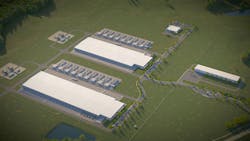Data centers will continue to be one of the most active construction niches for the foreseeable future.
One real estate report said that through mid-2023 data center construction was up +25% YOY, and by all indications, 2024 should also be a big year. CBRE’s North America Data Center Trends H1 2023 report said a record 2,287.6 MW was under construction in key markets in 2023, a +25% year-over-year increase. “Strong demand and developer appetite continues to drive new construction,” the report said. “However, a lack of readily available power and extended lead times for key pieces of electrical infrastructure are delaying construction timelines.”
Over the past two decades, the construction of more than 200 data centers in Northern Virginia’s Fairfax and Loudon Counties west of Washington, DC, has created the largest concentration of data centers in the United States. CBRE said this market has an inventory of 2,254.1 megawatts, four times as much as the #2 market – the Dallas-Fort Worth metro. Other markets in CBRE’s top tier for data center capacity when ranked by megawatt inventory are Silicon Valley, Chicago, Phoenix, Atlanta New York, Chicago and Hillsboro, OR.
The growth of this market is spreading to new geographic market areas across the United States, and some smaller and mid-sized market areas are becoming hot spots for data centers. In recent months, plans for new data centers or the expansion of existing facilities have also been announced in Ohio, Mississippi and Salt Lake City.
Much of the new data center capacity is being added to satisfy the appetite that AI (artificial intelligence) applications have for computing power. (See chart for several other data center projects now in the pipeline).
For example, Amazon, Google, QTS Data Centers and Edged Energy plan to spend a combined total of no less than $8 billion on upgrades to their existing facilities in and around New Albany, OH, and the Columbus, OH, metro. Meta also has a large data center in the area.
Eagle Mountain, UT, near Provo, UT, and just south of Salt Lake City, has also become a hub for data centers. The Tract development company recently announced that it had purchase 668 acres there for its $7-billion Project Tripletail. Another larger project is being planned in Madison County, MS, where Amazon Web Services will invest $10 billion to build two data center complexes.
A Wall Street Journal report also pointed to growth. It said that “Spending in the global AI infrastructure market — including data centers, as well as networks and other hardware that supports the use of AI applications—is expected to reach $422.55 billion by 2029, growing at a compound annual rate of 44% over the next six years, according to research firm Data Bridge Market Research.”
Along with requiring a mountain of electrical construction materials, including wire and cable, cable tray, connectors, circuit protection and backup generators, the next generation of data centers will also require enhanced cooling systems to handle larger power requirements.
The WSJ article said data centers running AI applications draw substantially more power than data centers servicing other applications and that a stack of servers in an AI data center can draw 50 kilowatts or more per rack, compared with roughly 7 kilowatts per rack in other data centers. A Forrester Research analysis quoted in the WSJ article said AI requires “an eight-lane road, not a two-lane road to power its applications.”
While the future looks bright for the electrical industry in this market, several obstacles exist that could tamp down momentum. It’s getting tougher to find land for data center development in some of the more populated metros that want to attract these facilities. In some of these areas, there’s local opposition to these developments because of the amount of water they need for cooling. The supply issues with switchgear can also bedevil construction timelines with data centers.
Despite these challenges, the data center should remain one of the most lucrative market segments for this industry.
About the Author
Jim Lucy
Editor-in-Chief
Over the past 40-plus years, hundreds of Jim’s articles have been published in Electrical Wholesaling and Electrical Marketing newsletter on topics such as the impact of new competitors on the electrical market’s channels of distribution, energy-efficient lighting and renewables, and local market economics. In addition to his published work, Jim regularly gives presentations on these topics to C-suite executives, industry groups and investment analysts.
He launched a new subscription-based data product for Electrical Marketing that offers electrical sales potential estimates and related market data for more than 300 metropolitan areas, and in 1999 he published his first book, “The Electrical Marketer’s Survival Guide” for electrical industry executives looking for an overview of key market trends.
While managing Electrical Wholesaling’s editorial operations, Jim and the publication’s staff won several Jesse H. Neal awards for editorial excellence, the highest honor in the business press, and numerous national and regional awards from the American Society of Business Press Editors. He has a master’s degree in Communications and a bachelor’s degree in Journalism from Glassboro State College, Glassboro, N.J. (now Rowan University).

